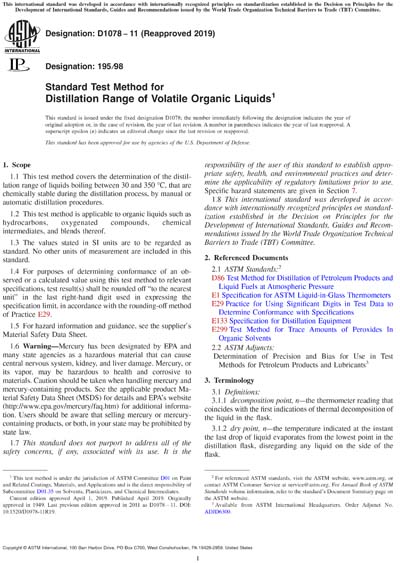Most recent
ASTM D1078-11(2019)
Standard Test Method for Distillation Range of Volatile Organic Liquids
1.1 This test method covers the determination of the distillation range of liquids boiling between 30 and 350 °C, that are chemically stable during the distillation process, by manual or automatic distillation procedures.
1.2 This test method is applicable to organic liquids such as hydrocarbons, oxygenated compounds, chemical intermediates, and blends thereof.
1.3 The values stated in SI units are to be regarded as standard. No other units of measurement are included in this standard.
1.4 For purposes of determining conformance of an observed or a calculated value using this test method to relevant specifications, test result(s) shall be rounded off “to the nearest unit” in the last right-hand digit used in expressing the specification limit, in accordance with the rounding-off method of Practice E29.
1.5 For hazard information and guidance, see the supplier's Material Safety Data Sheet.
1.6 Warning—Mercury has been designated by EPA and many state agencies as a hazardous material that can cause central nervous system, kidney, and liver damage. Mercury, or its vapor, may be hazardous to health and corrosive to materials. Caution should be taken when handling mercury and mercury-containing products. See the applicable product Material Safety Data Sheet (MSDS) for details and EPA’s website (http://www.epa.gov/mercury/faq.htm) for additional information. Users should be aware that selling mercury or mercury-containing products, or both, in your state may be prohibited by state law.
1.7 This standard does not purport to address all of the safety concerns, if any, associated with its use. It is the responsibility of the user of this standard to establish appropriate safety, health, and environmental practices and determine the applicability of regulatory limitations prior to use. Specific hazard statements are given in Section 7.
1.8 This international standard was developed in accordance with internationally recognized principles on standardization established in the Decision on Principles for the Development of International Standards, Guides and Recommendations issued by the World Trade Organization Technical Barriers to Trade (TBT) Committee.
Content Provider
ASTM International [astm]






